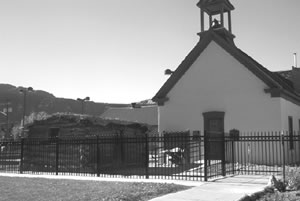Newly renovated
DUP Building dates back to 1888
by Jeff Richards
One
hundred fifteen years ago, in 1888, work was begun on the
first church ever built in Moab. A one-and-a-half acre parcel
of land was donated by O.W. Warner in Lot 1 Block 18, in
on the north side of Center Street at about 200 East (just
north of the modern-day “Sun Court” basketball
court between Star Hall and the Center Street gym building).

The proposed building was to be a meetinghouse for members
of the Church of Jesus Christ of Latter-day Saints. Warner
was joined by Henry Holyoak and O.D. Allan as the appointed
members of the building committee. A one-room building (with
a vaulted ceiling) was then built over the next several
months, with LDS church members donating labor, money, and
materials needed for the project. Angus Stocks supervised
the laying of the stone foundation and building of the adobes
(which were constructed at the Jonathan Huff property).
Hyrum Allen hauled the rock to the site from the canyon
east of town. Carpenter J.H. Staniford supervised the carpentry
work. Raw lumber and woodwork were brought down in wagons
from Salt Lake City, including doors, shingles, and window
frames.
In early May of 1889, the first church services were held
in the building, but the LDS members soon realized that
the building was already too small for their needs. Work
began almost immediately on a smaller second room, which
was built adjacent to the west end of the building and perpendicular
to the first room, giving the finished building a “T”
shape. Those helping on this phase of the project included
the aforementioned workers, plus Bill Bliss (stone cutter),
John Holyoak, Mary Murphy, Henry Holyoak (who sawed lumber),
Dick Westwood (who hauled sand), Randolph Stewart (the bishop
of the LDS ward), J.H. Johnson, Andrew Somerville, Charlie
McConkie, Myron Lance. William Pierce, and Arthur Taylor.
Many of these pioneers’ surnames are familiar to Moab
residents today, as hundreds of their descendants continue
to populate the Moab area.
The finished two-room building was formally dedicated at
a stake conference meeting in the fall of 1890. Moab was
incorporated as a town a dozen years later, on Dec. 30,
1902. The LDS Church members continued to hold their regular
meetings in the building until December of 1926, when a
new red brick meetinghouse was finished nearby. The old
church and property were then deeded to the Grand County
School District. School classes were held in the building
from 1954-64 until a new high school was built (the site
of the current middle school). The Moab chapter of the Daughters
of Utah Pioneers has used the building for their meetings
since 1937. Today, the old church building still serves
as the DUP’s headquarters and is familiarly known
as “the DUP building.”
Modern day visitors to the DUP building will also notice
an old log cabin located at the southeast corner. The cabin
dates back to 1881, and is one of the oldest buildings in
Moab. It was built by the aforementioned Bishop Stewart
for his third plural wife Marietta. Later occupants of the
cabin included the Stanley family, who moved from Wolfe
Ranch in present-day Arches National Park in 1908, and uranium
miner Howard Balsley and Grand Valley Times newspaper editor
Loren “Bish” Taylor (1892-1972), who lived there
around 1912. The log cabin is listed as a historic landmark
on the National Register of Historic Places.
The local DUP chapter recently completed a series of renovation
projects on their building, culminating in the installation
of a new black wrought-iron fence around the property in
November.
In September, new landscaping was put in, along with rocks
and gravel. The swamp cooler was hung from the west outside
wall with a metal frame and wires, instead of being supported
by a wooden structure. Local Boy Scout Trevor Knutson supervised
this phase of the work as part of the requirements for his
Eagle Scout award, enlisting the help of numerous other
Boy Scouts and their leaders.
Various other individuals and groups helped make the improvements
possible, said Hallie Tibbitts, who has been president of
the Moab DUP for the past six years. They included David
Dalton, who restored the log cabin, repairing the roof and
chinking cracks in the walls, Glen Wilson, who put in a
new sidewalk and the drainage system on the west side of
the building preparation for the new fence, Glen Holyoak,
who donated large rocks for the landscaping, and Charlie
Harrison, who hauled the rocks to the building. In addition,
Rholand Murphy hauled loads of dirt, and hauled and placed
the gravel to help with landscaping. Annette, Orvel and
Greg Nelson hauled cobblestones for the drains and did most
of the design work for the landscaping.
Money for the DUP building projects (which actually started
in 1999) came via various generous donations, including
those from: Peter Lawson, The Quinney Foundation, The LDS
Foundation, Zions Bank, Spanish Trail Shell, GCHS classes
1948-1953, private individuals, and grants from the Eccles
Foundation, along with matching grants from the Utah State
Historical Society. Dale and Wilda Irish, Jan Jensen and
Hallie Tibbitts all assisted in the fundraising efforts.
Tibbitts said that the DUP members also earned money by
selling books that they have written about local pioneer
history, by selling handmade quilts at their annual Christmas
Bazaar and Food Sale held the first Friday in December,
and via a quilt raffle held last April. The quilts and books
are also available for sale year round. The DUP building
also serves as a pioneer museum of sorts, with many old
photos and their descriptions adorning the walls. The DUP
building is generally open on Wednesday evenings; visitors
wishing to see the inside the building at other times may
call Tibbitts at 259-5225.
 Moab
Historic Happenings December 2003
Moab
Historic Happenings December 2003